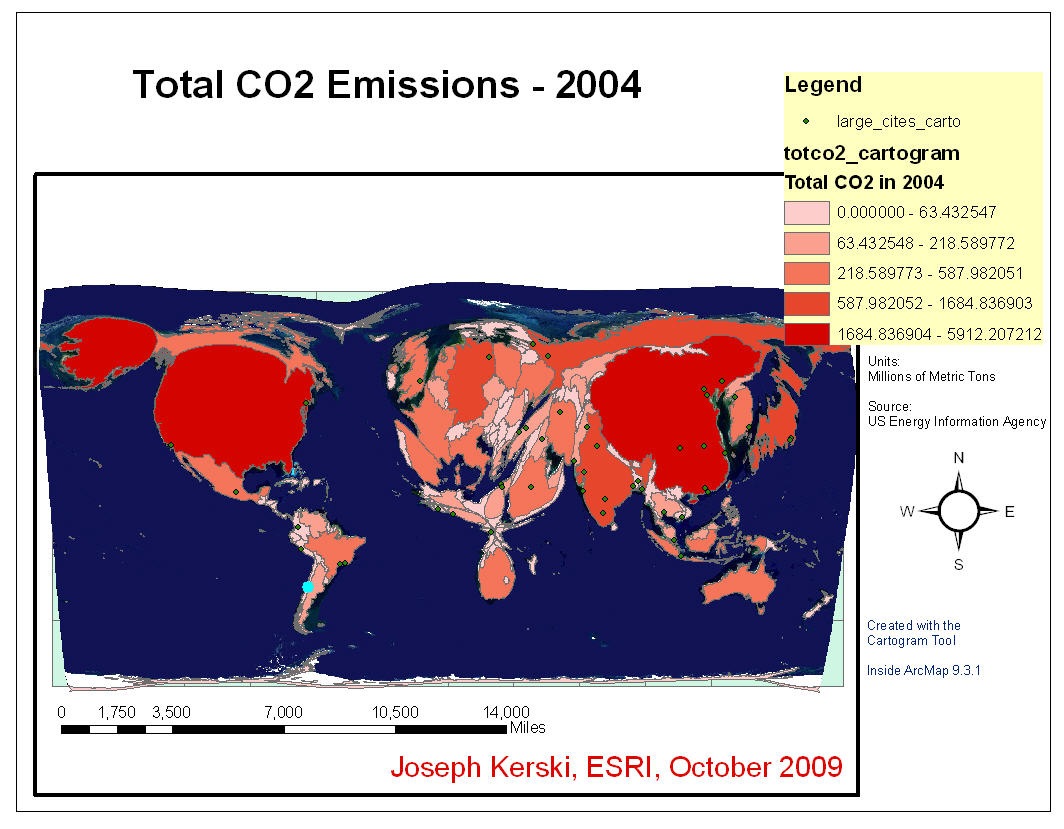Turn on suggestions
Auto-suggest helps you quickly narrow down your search results by suggesting possible matches as you type.
Cancel
- Home
- :
- All Communities
- :
- Industries
- :
- Education
- :
- Education Blog
- :
- Exploring Data Using Cartograms within ArcGIS Desk...
Exploring Data Using Cartograms within ArcGIS Desktop
Subscribe
831
0
06-28-2017 12:06 PM
- Subscribe to RSS Feed
- Mark as New
- Mark as Read
- Bookmark
- Subscribe
- Printer Friendly Page
06-28-2017
12:06 PM
Cartograms, because they distort our normal view of things, are wonderfully rich research and teaching tools. A distance cartogram shows relative travel times and directions within a network. An area cartogram is a map in which some variable is used instead of the land area in each polygon to compute the size of that polygon. Many of us remember using graph paper to make rectangular area cartograms as undergraduates (but perhaps I am dating myself). Today, one can use Web GIS and desktop GIS to create cartograms. For example, nearly 700 variables can be mapped on www.worldmapper.org, and the data can be downloaded as Excel spreadsheets and analyzed within ArcGIS.
To dig deeper and make your own cartograms, with the ability to do bivariate analysis within a GIS environment, use the ArcScript cartogram tool that Tom Gross in the ESRI Applications Prototype Lab created, on: http://arcscripts.esri.com/details.asp?dbid=15638. How can a GIS, which focuses on the accurate spatial representations of features, be used to create cartograms? Try this script and find out!
Once you install the cartogram tool, inside ArcMap, access ArcToolbox. Create a toolset, add the cartogram tool, and run it. The intuitive interface allows specifying input and output, and even comes with a nice assortment of international population and other variables to practice on. You can distort the base layers so that your cartogram can include the distorted layers for reference. I did this for cities, a 30-degree world grid, and a satellite image of the Earth to see these reference layers overlaid on my cartogram.
In this example, I chose to map the total CO2 emissions by country in 2004, in millions of metric tons, from the US Energy Information Agency. What patterns do you notice?
The cartogram map layer has to be written into a geodatabase, but otherwise, the tool has few restrictions. I am very pleased cartographically with the results, and the methodology of how the cartograms are generated is well documented.
What other variables and scales could you map and analyze as cartograms?
You must be a registered user to add a comment. If you've already registered, sign in. Otherwise, register and sign in.
About the Author
I believe that spatial thinking can transform education and society through the application of Geographic Information Systems for instruction, research, administration, and policy.
I hold 3 degrees in Geography, have served at NOAA, the US Census Bureau, and USGS as a cartographer and geographer, and teach a variety of F2F (Face to Face) (including T3G) and online courses. I have authored a variety of books and textbooks about the environment, STEM, GIS, and education. These include "Interpreting Our World", "Essentials of the Environment", "Tribal GIS", "The GIS Guide to Public Domain Data", "International Perspectives on Teaching and Learning with GIS In Secondary Education", "Spatial Mathematics" and others. I write for 2 blogs, 2 monthly podcasts, and a variety of journals, and have created over 6,500 videos on my Our Earth YouTube channel.
Yet, as time passes, the more I realize my own limitations and that this is a lifelong learning endeavor: Thus I actively seek mentors and collaborators.
Labels
-
Administration
78 -
Announcements
80 -
Career & Tech Ed
1 -
Curriculum-Learning Resources
259 -
Education Facilities
24 -
Events
72 -
GeoInquiries
1 -
Higher Education
596 -
Informal Education
281 -
Licensing Best Practices
91 -
National Geographic MapMaker
33 -
Pedagogy and Education Theory
226 -
Schools (K - 12)
282 -
Schools (K-12)
273 -
Spatial data
35 -
STEM
3 -
Students - Higher Education
246 -
Students - K-12 Schools
129 -
Success Stories
36 -
TeacherDesk
1 -
Tech Tips
119
- « Previous
- Next »
